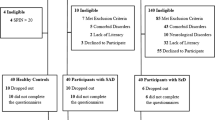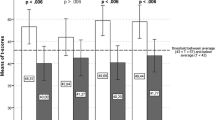Abstract
Recently, social anxiety disorder (SAD) and paranoia have been demonstrated to be closely related. However, data were primarily drawn from adult community samples or patients with schizophrenia. The present study used a cross-sectional design to evaluate a sample of adolescents with SAD (n = 30, mean age 15.3 ± 0.9 years) compared with an age- and sex-matched group of healthy controls (n = 26, mean age 15.9 ± 1.6 years). The SAD group displayed more frequent and intense paranoid thoughts than the control group (t = 4.16, p < 0.001). The level of paranoid thoughts was significantly predicted by the degree of social phobia, even after adjusting for sex and other anxiety disorders, although adjusting for depression slightly reduced the extent and significance of the prediction. A lack of awareness about the association between SAD and paranoia may lead to incorrect diagnoses (e.g. misdiagnosis of psychotic disorders), or it may negatively influence the (psycho)therapeutic process and patient outcomes.
Similar content being viewed by others
References
Gilbert P, Boxall M, Cheung M, Irons C (2005) The relation of paranoid ideation and social anxiety in a mixed clinical population. Clin Psychol Psychother 12:124–133
Rietdijk J, Van Os J, Graaf RD, Delespaul P, Gaag MVD (2009) Are social phobia and paranoia related, and which comes first? Psychosis 1:29–38
Schutters SI, Dominguez MD, Knappe S, Lieb R, van Os J, Schruers KR et al (2012) The association between social phobia, social anxiety cognitions and paranoid symptoms. Acta Psychiatr Scand 125:213–227
Heimberg RG (1995) Social phobia: diagnosis, assessment, and treatment. Guilford Press, New York
Freeman D, Garety PA, Kuipers E, Fowler D, Bebbington PE (2002) A cognitive model of persecutory delusions. Br J Clin Psychol 41:331–347
Freeman D, Garety PA (2000) Comments on the content of persecutory delusions: does the definition need clarification? Br J Clin Psychol 39(Pt 4):407–414
Freeman D, Garety PA, Bebbington PE, Smith B, Rollinson R, Fowler D et al (2005) Psychological investigation of the structure of paranoia in a non-clinical population. Br J Psychiatry 186:427–435
Martin JA, Penn DL (2001) Social cognition and subclinical paranoid ideation. Br J Clin Psychol 40:261–265
Freeman D, Gittins M, Pugh K, Antley A, Slater M, Dunn G (2008) What makes one person paranoid and another person anxious? The differential prediction of social anxiety and persecutory ideation in an experimental situation. Psychol Med 38:1121–1132
Taylor K, Stopa L (2013) The fear of others: a pilot study of social anxiety processes in Paranoia. Behav Cogn Psychother 41:66–88
Tone EB, Goulding SM, Compton MT (2011) Associations among perceptual anomalies, social anxiety, and paranoia in a college student sample. Psychiatry Res 188:258–263
Johns LC, Cannon M, Singleton N, Murray RM, Farrell M, Brugha T et al (2004) Prevalence and correlates of self-reported psychotic symptoms in the British population. Br J Psychiatry 185:298–305
Michail M, Birchwood M (2009) Social anxiety disorder in first-episode psychosis: incidence, phenomenology and relationship with paranoia. Br J Psychiatry 195:234–241
Pallanti S, Quercioli L, Hollander E (2004) Social anxiety in outpatients with schizophrenia: a relevant cause of disability. Am J Psychiatry 161:53–58
Tibbo P, Swainson J, Chue P, LeMelledo JM (2003) Prevalence and relationship to delusions and hallucinations of anxiety disorders in schizophrenia. Depress Anxiety 17:65–72
Burstein M, He JP, Kattan G, Albano AM, Avenevoli S, Merikangas KR (2011) Social phobia and subtypes in the national comorbidity survey-adolescent supplement: prevalence, correlates, and comorbidity. J Am Acad Child Adolesc Psychiatry 50:870–880
Ronald A, Sieradzka D, Cardno AG, Haworth CM, McGuire P, Freeman D (2014) Characterization of psychotic experiences in adolescence using the specific psychotic experiences questionnaire: findings from a study of 5000 16-year-old twins. Schizophr Bull 40:868–877
Kaufman J, Birmaher B, Brent D, Rao U, Flynn C, Moreci P et al (1997) Schedule for affective disorders and schizophrenia for school-age children-present and lifetime version (K-SADS-PL): initial reliability and validity data. J Am Acad Child Adolesc Psychiatry 36:980–988
Masia-Warner C, Storch EA, Pincus DB, Klein RG, Heimberg RG, Liebowitz MR (2003) The Liebowitz social anxiety scale for children and adolescents: an initial psychometric investigation. J Am Acad Child Adolesc Psychiatry 42:1076–1084
Heimberg RG, Horner KJ, Juster HR, Safren SA, Brown EJ, Schneier FR et al (1999) Psychometric properties of the Liebowitz Social Anxiety Scale. Psychol Med 29:199–212
Kovacs M (1985) The children’s depression, inventory (CDI). Psychopharmacol Bull 21:995–998
Wong KK, Freeman D, Hughes C (2014) Suspicious young minds: paranoia and mistrust in 8- to 14-year-olds in the U.K. and Hong Kong. Br J Psychiatry 205:221–229
Freeman D, Dunn G, Fowler D, Bebbington P, Kuipers E, Emsley R et al (2013) Current paranoid thinking in patients with delusions: the presence of cognitive-affective biases. Schizophr Bull 39:1281–1287
Bentall RP, Rowse G, Shryane N, Kinderman P, Howard R, Blackwood N et al (2009) The cognitive and affective structure of paranoid delusions: a transdiagnostic investigation of patients with schizophrenia spectrum disorders and depression. Arch Gen Psychiatry 66:236–247
Author information
Authors and Affiliations
Corresponding author
Ethics declarations
Conflict of interest
Dr. Masi was on the advisory boards for Eli Lilly, Shire and Angelini, has received research grants from Eli Lilly and Shire, and has been speaker for Eli Lilly, Shire, Lundbeck, Otsuka and Novartis. All other authors have no conflicts of interest to declare.
Rights and permissions
About this article
Cite this article
Pisano, S., Catone, G., Pascotto, A. et al. Paranoid Thoughts in Adolescents with Social Anxiety Disorder. Child Psychiatry Hum Dev 47, 792–798 (2016). https://doi.org/10.1007/s10578-015-0612-5
Published:
Issue Date:
DOI: https://doi.org/10.1007/s10578-015-0612-5




